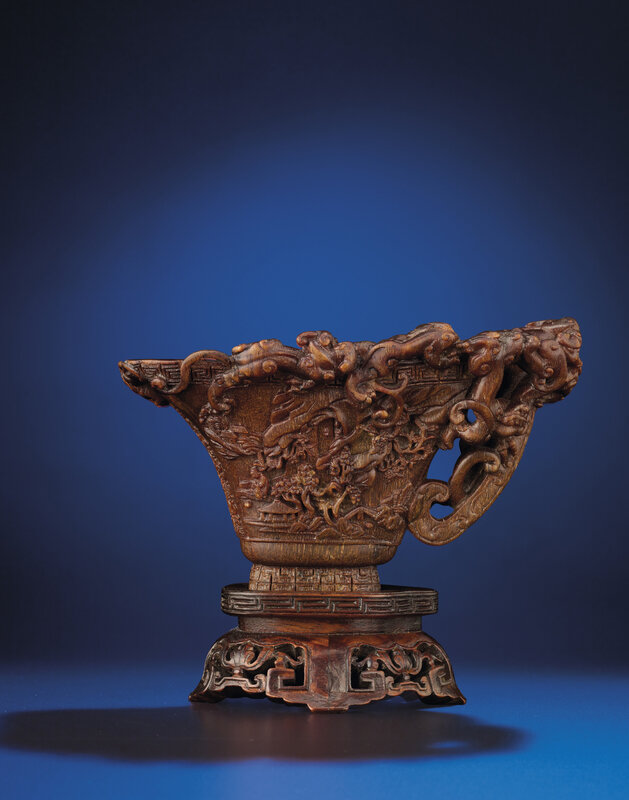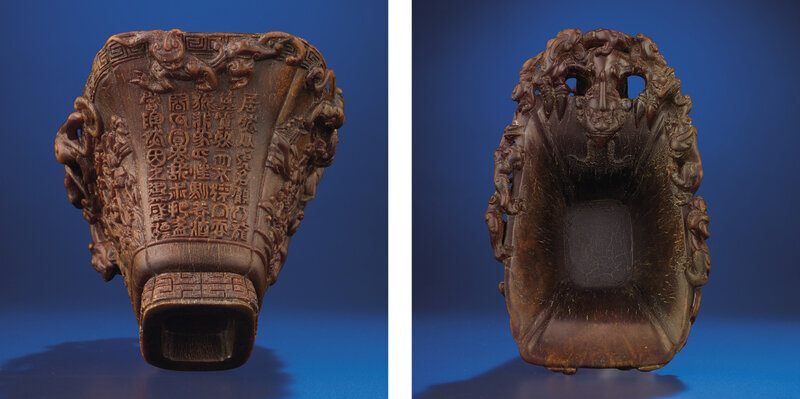A rare and finely carved 'Nine dragons' rhinoceros horn libation cup, Ming dynasty, early 17th century
Lot 2171. A rare and finely carved 'Nine dragons' rhinoceros horn libation cup, Ming dynasty, early 17th century; 6 in. (15 cm.) wide. Estimate HKD 900,000 - HKD 1,500,000. Price realised HKD 3,140,000. © Christie's Images Ltd 2012
Of archaistic form, the flaring sides are raised on a gently spreading foot carved in low relief with a squared double scroll. Both sides are carved to depict immortals in a mountainous landscape retreat amidst prunus, pine and wutong. The handle is formed by a powerful winged dragon with a pair of arched horns carved in openwork. Its head extends over the edge of the rim into the interior, and further entangled by eight chi dragons encircling the rim. The exterior is carved in relief under the spout with a forty-character archaistic inscription, neatly arranged in five vertical lines. The material is of a rich walnut brown tone, wood stand, box.
Provenance: Christie's New York, 2 December 1985, lot 368
Literature: T. Fok, Connoisseurship of Rhinoceros Horn Carving in China, Hong Kong, 1999, p. 54, no. 7
Exhibited: Hong Kong Museum of Art, Metal, Wood, Water, Fire and Earth: Gems of Antiquities Collections in Hong Kong, 2002-2005
Note: It is unusual to find archaistic inscriptions rendered in this form on rhinoceros horn libation cups. The format of the text, arranged into five vertical lines, is evidently a Ming period interpretation of early characters that have been found inscribed on surfaces of bronzes dated to Shang and Zhou dynasties.
The inscription is a short poem complementing the design of the vessel and may be translated as:
Even though it shares the same Tiger* name,
when one looks at it very carefully it is in fact a dragon.
It appears to be fierce,
These creatures are in nature very gentle,
and their horns can be used as wine vessels.
How appreciative it is to hold one of these cups,
it completes ones delight.
*The reference to tiger is derived from the ancient inter-changeable use of the word "chihu" (horned tiger) and "chilong" (horned dragon).
Christie's. Important Chinese Ceramics and Works of Art, 28 November 2012, Hong Kong

/https%3A%2F%2Fprofilepics.canalblog.com%2Fprofilepics%2F1%2F0%2F100183.jpg)
/https%3A%2F%2Fstorage.canalblog.com%2F03%2F02%2F119589%2F96711876_o.jpg)
/https%3A%2F%2Fstorage.canalblog.com%2F11%2F31%2F119589%2F94773502_o.jpg)
/https%3A%2F%2Fstorage.canalblog.com%2F20%2F83%2F119589%2F94772815_o.jpg)
/https%3A%2F%2Fstorage.canalblog.com%2F26%2F72%2F119589%2F75604929_o.jpg)
/https%3A%2F%2Fstorage.canalblog.com%2F59%2F60%2F119589%2F26458628_o.jpg)




/image%2F1371349%2F20240324%2Fob_e3ecaa_1.jpg)
/image%2F1371349%2F20240324%2Fob_ef0abf_1.jpg)
/image%2F1371349%2F20240324%2Fob_64049b_1.jpg)
/image%2F1371349%2F20240324%2Fob_a0994e_1.jpg)